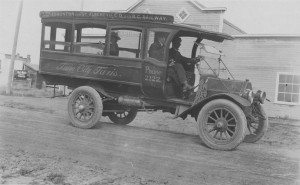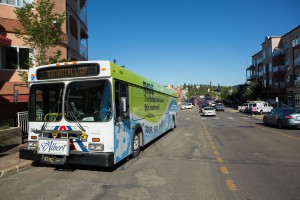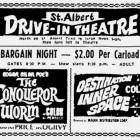Then & Now
St.Albert Transit Then & Now
March, 2016
How’s this for a bold vision: Improve the efficiency and comfort of travel times between the urban centre of Edmonton and the sleepy, bedroom community of St. Albert. While at it, use state-of-the-art hybrid technologies to make the trip faster than ever before. In fact, make the ride quieter, more efficient and luxurious, too. Grandiose? Unaffordable? Impossible? Perhaps. But 100 years ago it became a reality—for an entire six months… From the days of the Interurban Railway to today, here’s a look back at St. Albert’s transit system.
The Interurban Railway
The brainchild of entrepreneur Raymond Brutinel, the Interurban Railway would—eventually—revolutionize travel between the communities of St. Albert and Edmonton. In the early 1900s, St. Albert was considered an attractive resort community with water features and plenty of fertile land. What wasn’t attractive was the unpaved road between it and its bustling neighbour, Edmonton. Though it was accessible in good weather, the road often became impassible when conditions were wet and muddy—a true barrier to St. Albert’s progress.

The idea of a railway between the two communities was first proposed in 1908; however, it took Brutinel’s vision to get the plan approved and set in motion. Not one to do things by the book, Brutinel procured a hybrid streetcar for the 30-minute route. It was gasoline-electric, quieter than a standard railroad train, could accommodate 44 riders and travel at 35 miles per hour.
On September 30, 1913, the Interurban Rail service commenced but abruptly ended six month later due to fire. In the end, the gasoline partially powering the hybrid technology also became the source of the railway’s demise.
Despite the community’s best efforts to reignite Brutinel’s vision of a light-rail transit service between the two communities, in 1917 the idea died on the drawing board after three years of debate. Rails were dismantled and sold for scrap to support the war efforts, and all remnants of Interurban Rail disappeared.
1950s, 60s & 70s
Many transit operators took interest in the Edmonton to St. Albert run during the 50s and 60s, including Northland Arrow, Sunburst Bus Lines, Canadian Coachways and Western Bus Lines.
It wasn’t until the 1970s that St. Albert assumed responsibility for an intercommunity rail service. In 1974, the Edmonton Transit System was contracted to run three buses during peak times. The route carried about 300 commuters at a fare of $0.50 per rider.
In 1976, the Town of St. Albert purchased 10 of its own buses and ran a service to the University of Alberta (U of A). The Briggs Bus Lines provided local service using yellow school buses.
1980s & 90s
The birth of St. Albert Transit took place in 1986 with the construction of a transit garage in Campbell Industrial Park. The bus fleet was comprised of 23 GMC transit buses with drivers provided by Grey Goose Bus Lines.
In the 90s, St Albert became the first community in Western Canada to purchase and operate one of the new 18-metre articulated buses.
2000s & Now
With a new logo (StAT) and website in place, St. Albert Transit celebrated its one millionth passenger trip. Since then, the community has made efforts towards the operation of a more eco-friendly service, including initiatives promoting an idle-free policy and ‘take the bus rather than your car’ campaigns.
towards the operation of a more eco-friendly service, including initiatives promoting an idle-free policy and ‘take the bus rather than your car’ campaigns.
In 2007, students benefited from a three-year U-Pass pilot project that transported riders to the U of A and MacEwan University. The program was later approved in 2010 and added NAIT to the list.
Today, StAT operates a fleet of 55 fully accessible, bike-friendly buses. To accommodate all riders, buses are equipped with retractable ramps and designed with low floors and curb-height step capability.
The StAT website is very user friendly with instructional videos, tips and guidelines. It’s a great way to travel in St. Albert. t8n
Did You Know?
In 1913, for $0.25 you could select one of three departures times and enjoy five stops when riding the Edmonton Interurban Railway.
The StAT travels 2.2 million kilometres per year and carries over 1.25 million passengers.
Twin City Transfer Company bus service between Edmonton and St. Albert, 1914 to 1917. Photo credit: Provincial Archives of Alberta, PR1973.0419
The Botanical Bus Loop is a St Albert Transit route that connects tourists and residents to botanically themed attractions across the city, including the Enjoy Centre, the St. Albert Farmers’ Market and the St. Albert Botanical Park.
Photo credit: City of St. Albert













